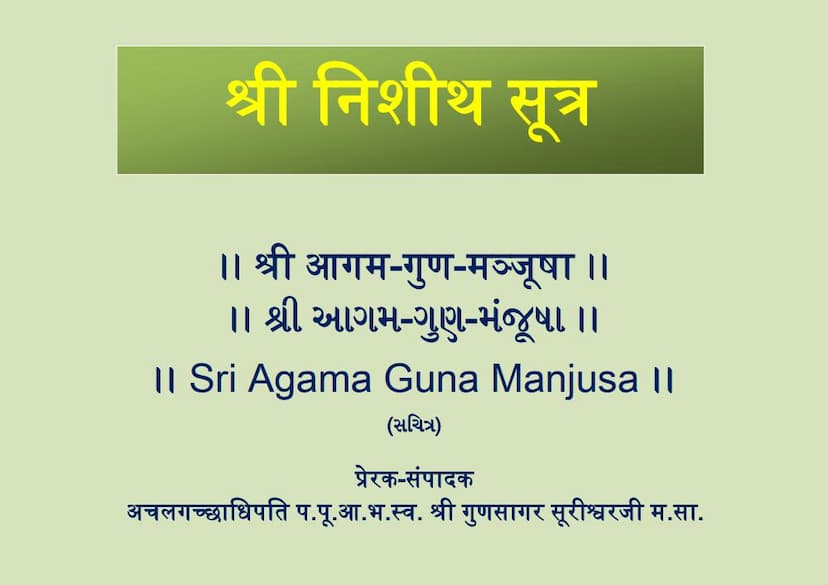Agam 34 Chhed 01 Nishith Sutra Shwetambar Agam Guna Manjusha
Added to library: September 1, 2025

Summary
This document is an excerpt from "Agam 34 Chhed 01 Nishith Sutra Shwetambar Agam Guna Manjusha" by Gunsagarsuri, published by Jina Goyam Guna Sarvoday Trust Mumbai. It is presented as a comprehensive guide to the 45 Jain Agamas, providing brief introductions to each. The text is divided into several sections, detailing different categories of Agamas:
I. Eleven Angas (Primary Scriptures): This section lists and briefly describes the foundational eleven Anga Sutras. Each description highlights the core subject matter and sometimes the number of chapters or verses. Key Angas mentioned include:
- Achārāṅga Sūtra: Focuses on the conduct of monks and lay followers, emphasizing the "ways of conduct" (charana-karana-anu-yoga).
- Sūtra-Kṛtāṅga Sūtra: Discusses various philosophical schools (ritualists, non-ritualists, etc.) and the "teaching of entity" (dravya-anu-yoga).
- Sthānāṅga Sūtra: Covers topics from calculation (ganita-anu-yoga) and the other three "anu-yogas" (teachings), detailing objects from one to ten.
- Samavāyāṅga Sūtra: Similar to Sthānāṅga Sūtra, it is a compendium that lists objects from one to countless quantities.
- Vyākhyā-prajñapti Sūtra (Bhagavati Sūtra): The largest Anga, containing questions and answers between Lord Mahavira and Gautama Ganadhara, covering all four "anu-yogas."
- Jñātādharmakathāṅga Sūtra: Deals with religious discourses (dharma-katha-anu-yoga).
- Upāsakadashāṅga Sūtra: Describes the twelve vows and the lives of ten great lay followers, integrating religious discourse and ways of conduct.
- Antagaḍadashāṅga Sūtra: Focuses on religious discourse, detailing the lives of souls attaining liberation.
- Anuttaraupapātika Dashāṅga Sūtra: Also deals with religious discourse, narrating the lives of souls who attain heavenly realms and then liberation.
- Praśna-vyākaraṇa Sūtra: Primarily concerned with the ways of conduct, presenting Lord Mahavira's answers to questions.
- Vipāka Sūtra: Divided into two parts: the fruition of misery and the fruition of happiness, illustrating the lives of sinful and virtuous souls.
II. Twelve Upangas (Subsidiary Scriptures): This section lists and describes twelve Upanga Sutras, often presented as elaborations or extensions of the Angas. Some prominent Upangas include:
- Aupapātika Sūtra: An Upanga of Achārāṅga Sūtra, describing a city, austerities, and disciples.
- Rāyapraśanīya Sūtra: An Upanga of Sūtra-Kṛtāṅga Sūtra, discussing a king's jurisdiction and deity worship.
- Jīvābhigama Sūtra: An Upanga of Sthānāṅga Sūtra, providing analysis of self (jiva) and non-self (ajiva) and rituals.
- Praśnāpanā Sūtra: An Upanga of Samavāyāṅga Sūtra, describing 36 steps or topics.
- Sūrya-prajñapti Sūtra and Chandra-prajñapti Sūtra: These two focus on calculation, detailing celestial movements and time.
- Jambudvīpa Prajñapti Sūtra: Also in calculation, it describes the Jambu continent in detail.
- Nirayāvali Sūtra: Part of the "Nirayāvali Pacaka," it describes a significant war and the fate of King Shrenika's sons.
- Kalpāvatamsaka Sūtra: Describes the lives of princes.
- Pushpika Upanga Sūtra and Pushpachulika Upanga Sūtra: These discuss deities and their previous births.
- Vr̥ṣṇidaśā Sūtra: Narrates stories of the Vrishni dynasty.
III. Ten Payanna Sutras: This section outlines ten Payanna Sutras, often dealing with specific practices, philosophical concepts, or astronomical details. Examples include:
- Āturā-pratyākhyāna Prakīrņaka Sūtra: Deals with final practices and improving one's death.
- Bhakta-parijñā Prakīrņaka Sūtra: Describes types of death and related practices.
- Santhāraka Prakīrņaka Sūtra: Extols the virtue of "santhara" (voluntary cessation of eating).
- Tandula-vaiyālikā Prakīrņaka Sūtra: Referred to as an "ocean of detachment," it discusses lifespan and sustenance.
- Candāvijaya Prakīrņaka Sūtra: Focuses on practices that improve one's death.
- Devendra-stava Prakīrņaka Sūtra: Presents hymns to the Lord by Indra.
- Marana-samādhi Prakīrņaka Sūtra: Details final religious practices related to death.
- Mahāpratyākhyāna Prakīrņaka Sūtra: Describes practices for monks at the time of death.
- Gaṇivijaya Prakīrņaka Sūtra: Summarizes major astrological treatises.
IV. Six Cheda-Sutras: This section lists the six Cheda-Sutras, which are considered critical for monastic discipline and are generally studied by advanced monks. They deal with rules, exceptions, and expiation. The text emphasizes the strict qualifications required for studying these Sutras. The six Cheda-Sutras are:
- Nishith Sutra
- Mahānishith Sutra
- Vyavahāra Sutra
- Jitakalpa Sutra
- Panchakalpa Sutra
- Dasha Shrutaskandha Sutra
The provided text then delves into specific details of Nishith Sutra (Nisiha Chedasuttam), particularly its chapters (Uddeshak) and the penances (prāyashchitta) associated with various transgressions. The content of the Uddeshaks indicates a strong focus on disciplinary rules and the consequences for breaking them, covering a wide range of actions from improper conduct with the opposite sex, handling of food and clothing, to interactions with non-Jains and the environment.
V. Four Mula Sutras: This section briefly introduces the four Mula Sutras, considered foundational for monks and nuns.
- Dashavaikalika Sutra: Described as a "lake of nectar" for monks and nuns in the current era, it contains ten lessons and two "chūlikās" (appendices).
- Uttarādhyayana Sutra: Contains the final sermons of Lord Mahavira, focusing on detachment and monastic conduct.
- Anuyogadvāra Sutra: Considered the "key to all Agamas," it explains the methodologies of scriptural interpretation (anuyoga) and is crucial for beginners.
- Avashyaka Sutra: Essential for all four classes of Jains, it outlines six daily obligatory duties.
VI. Two Chūlikās: This section mentions two Chūlikās:
- Nandi Sūtra: Contains hymns, analogies for the monastic community, and information about Tirthankaras and Ganadharas.
- Anuyogadvāra Sūtra: While mentioned as a Mula Sutra, it's also classified here.
The latter part of the document (Pages 8-25) provides detailed content from the Nishith Sutra, specifically outlining the offenses and corresponding penances prescribed for each "Uddeshak" (chapter). This section appears to be a Gujarati translation and explanation of the original Prakrit or Sanskrit verses of the Nishith Sutra. The descriptions in the Gujarati section are very specific, detailing actions like improper use of materials, violations of ascetic vows, incorrect handling of food and alms bowls, unethical interactions, and various forms of misconduct, all linked to specific penances.
In essence, this document serves as a directory of the Jain Agamas, with a significant portion dedicated to the detailed regulations and disciplinary measures found within the Nishith Sutra, a crucial text for Shwetambar monastic tradition.